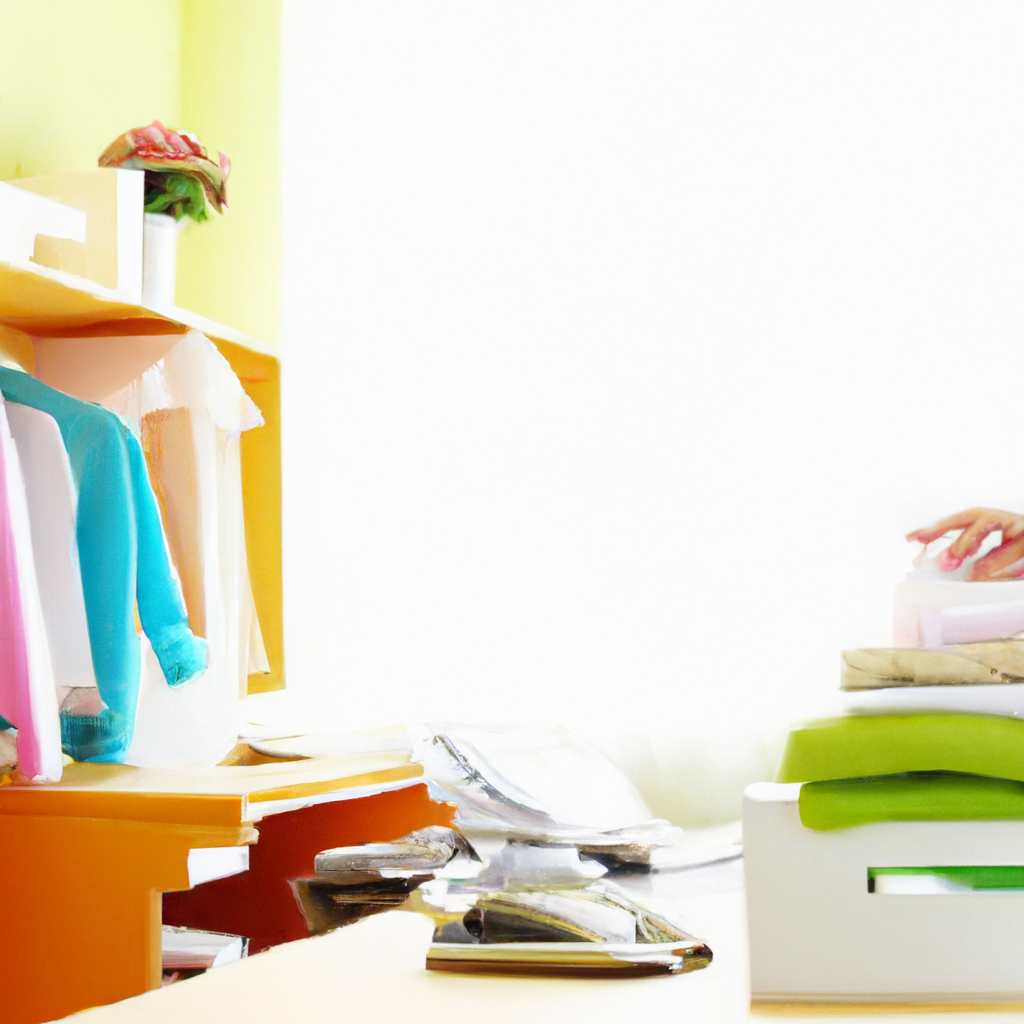Have you ever felt overwhelmed by the clutter in your home but thought you couldn’t afford to organize it? Well, fret no more! In this article, we will explore practical and budget-friendly tips to help you tackle the chaos and transform your living space into an organized and functional haven. Say goodbye to the stress and frustration that clutter brings, and say hello to a stylish and organized home without breaking the bank. Get ready to roll up your sleeves, because it’s time to declutter and organize your home on a budget!
Organizing Your Home on a Budget
Keeping your home organized and clutter-free doesn’t have to break the bank. With a little creativity and resourcefulness, you can transform your living space into a tidy oasis without spending a fortune. In this article, we will explore ten strategies to help you organize your home on a budget.
1. Decluttering
1.1 Assess your belongings
Before diving into the organizing process, take a moment to assess your belongings. This step will help you determine what you truly need and what items you can live without. Start by going room by room and evaluate each item. Ask yourself if it serves a purpose and if it brings you joy. This process of decluttering will not only make your home tidier but will also create a sense of clarity and peace in your mind.
1.2 Sort items into categories
Once you have assessed your belongings, it’s time to sort them into categories. Create piles for different types of items such as clothes, books, kitchenware, and electronics. This step will allow you to see how much you have of each category and make it easier to organize them later.
1.3 Decide what to keep, donate, or sell
After sorting your items, it’s crucial to decide what to keep, donate, or sell. Only keep the items that you genuinely need and use regularly. Consider donating items that are in good condition but no longer serve you. Selling unwanted belongings can not only declutter your space but also provide you with some extra cash. Online platforms such as auction sites or local marketplaces are excellent places to sell your items.
2. Use What You Already Have
2.1 Repurpose items
One of the most cost-effective ways to organize your home is to repurpose items you already have. Get creative and think outside the box. For example, a shoebox can become a neat storage container for small accessories or a mason jar can be a stylish pen holder. By repurposing items, you not only save money but also reduce waste and add a personal touch to your organization.
2.2 Utilize storage containers
If you have storage containers lying around unused, now is the time to put them to good use. Whether it’s plastic bins, shoe organizers, or baskets, utilize these containers to keep your belongings in order. Group similar items together, and label the containers for easy access. This method not only maximizes space but also saves you from purchasing expensive storage solutions.
2.3 Create DIY storage solutions
If you can’t find the perfect storage solution, create your own! DIY projects are not only fun but also budget-friendly. Build shelves using repurposed wood or create hanging organizers out of fabric and hooks. The possibilities are endless, and you can tailor the design to fit your specific needs and style. Check out online tutorials or get inspired by home improvement blogs to get started.

3. Maximize Space
3.1 Utilize vertical space
When organizing your home, don’t forget to make use of vertical space. Install floating shelves on the walls for additional storage, or use over-the-door hangers to hang bags or coats. Vertical space is often underutilized but can provide ample room for items that would otherwise clutter your tables or countertops.
3.2 Make use of underutilized areas
Look for underutilized areas in your home that can be turned into storage spaces. For example, the space under your bed can be used to store out-of-season clothing or extra bedding. The area above your kitchen cabinets can house infrequently used appliances or decorative items. By tapping into these unused areas, you can create more storage without spending a dime.
3.3 Optimize closet and cabinet space
Closets and cabinets are often the primary spaces for storage. To maximize these areas, invest in organizers such as hanging shelves, over-the-door shoe racks, or stackable containers. Group similar items together and arrange them in a way that makes them easily accessible. Consider using vertical dividers in your cabinets to create more room for plates, pans, or lids. By optimizing your closet and cabinet space, you can keep your belongings organized and create a visually pleasing environment.
4. Shop Smart
4.1 Look for budget-friendly storage solutions
If you need additional storage solutions, don’t rush to the expensive department stores just yet. Instead, look for budget-friendly options that can satisfy your organizational needs. Discount stores or dollar stores often have a wide selection of storage containers, baskets, and bins at affordable prices. You can also find great deals online by comparing prices and reading customer reviews.
4.2 Check out thrift stores and yard sales
Thrift stores and yard sales can be treasure troves for affordable organizational items. Visit your local thrift stores and keep an eye out for storage containers, baskets, or even furniture pieces that can be repurposed for organization. With a bit of luck and persistence, you might find unique and useful items at a fraction of the cost.
4.3 Invest in multipurpose furniture
When it comes to furniture, look for pieces that offer both style and functionality. Invest in multipurpose furniture that can provide storage opportunities. For example, a coffee table with built-in drawers or ottomans with hidden compartments can be a perfect addition to your living room, offering a place to store blankets, magazines, or remote controls.

5. DIY Organizational Projects
5.1 Build a shoe rack
Shoes often clutter entryways, creating a messy first impression of your home. Instead of buying an expensive shoe rack, consider building your own. With a few pieces of wood, screws, and some basic tools, you can create a customized shoe rack that perfectly fits your space and holds all your footwear neatly.
5.2 Create a wall-mounted organizer
If your desk is cluttered with papers, pens, and office supplies, a wall-mounted organizer can be a game-changer. Repurpose materials such as corkboards, pegboards, or even an old picture frame to create a functional wall-mounted organizer. Hang it near your workspace for quick and easy access to essentials, allowing you to stay organized and focused.
5.3 Make your own drawer dividers
Drawer dividers are essential in keeping your drawers organized and preventing items from becoming jumbled together. Instead of buying pre-made dividers, make your own using simple materials such as cardboard, foam board, or even empty cereal boxes. Cut them to size and arrange them in your drawers to create custom compartments for various items.
6. Utilize Free Resources
6.1 Find digital organization apps
In today’s digital age, there are numerous free organization apps available for your smartphone or computer. These apps can help you manage your to-do lists, set reminders, and even declutter your digital files. Explore app stores or online resources to find the ones that best suit your needs.
6.2 Explore online tutorials and guides
The internet is a treasure trove of free resources when it comes to organization. Explore online tutorials and guides that provide step-by-step instructions on various organizing projects. From organizing your pantry to creating a capsule wardrobe, you can find practical advice and inspiration to help you declutter and organize your home without spending a penny.
6.3 Borrow organizing books from the library
Your local library is an excellent resource for organizing books that can provide valuable insights and strategies. Borrowing books on organization and decluttering will not only help you gain knowledge but also save money. Whether you’re a fan of Marie Kondo’s minimalism or prefer more practical organizational methods, you’re sure to find a book that resonates with you.
7. Repurpose Household Items
7.1 Use ice cube trays for jewelry organization
If your jewelry is constantly tangled and difficult to find, repurpose ice cube trays into jewelry organizers. The divided compartments in the trays are perfect for holding rings, earrings, and small accessories. Place the trays in your vanity drawer or on your dresser for easy access to your favorite pieces.
7.2 Transform magazine holders into file organizers
Magazine holders are incredibly versatile and can be repurposed into file organizers. Use them to store important documents, mail, or even notebooks. Arrange them on your desk or mount them on the wall to keep your work area clutter-free.
7.3 Reuse glass jars for pantry storage
Don’t throw away glass jars after using the contents. Instead, wash and reuse them for pantry storage. Glass jars are perfect for holding dry goods such as pasta, rice, or spices, and they add a touch of rustic charm to your pantry shelves. To take it a step further, you can paint the lids or attach labels for a more organized and aesthetically pleasing look.
8. Prioritize and Set Goals
8.1 Identify problem areas
Every home has its own unique problem areas that require organizing attention. Take a walk through your home and identify the areas that need your immediate attention. Is it the overflowing closet? The cluttered garage? By identifying these problem areas, you can prioritize your efforts and tackle them one by one.
8.2 Create a realistic organizing schedule
Organizing your entire home can be overwhelming, so break it down into manageable tasks and create a realistic organizing schedule. Set aside specific time slots each week to focus on different areas or categories. By spreading out the work and sticking to a schedule, you’ll avoid burnout and make steady progress toward your organizational goals.
8.3 Break down tasks into manageable steps
To make the organizing process less daunting, break down each task into smaller, manageable steps. For example, instead of setting a broad goal of organizing your entire kitchen, focus on decluttering the pantry one day and rearranging the dishes the next. By taking small steps, you’ll feel a sense of accomplishment along the way and stay motivated to continue organizing.
9. Maintain a Cleaning Routine
9.1 Establish daily decluttering habits
To prevent clutter from accumulating, establish daily decluttering habits. Set aside a few minutes each day to tackle small tasks, such as putting away stray items, clearing countertops, or organizing mail. Consistency is key, and these daily habits will help maintain a tidy home without having to dedicate significant amounts of time to decluttering.
9.2 Do regular deep cleanings
In addition to daily decluttering, schedule regular deep cleanings to ensure your home stays organized. This includes tasks such as dusting, vacuuming, and wiping down surfaces. Regular deep cleanings not only keep your home looking its best but also help you identify any areas that need reorganization or further decluttering.
9.3 Set up weekly cleaning schedules
To stay on top of cleaning tasks, create a weekly cleaning schedule. Assign specific days for different tasks, such as cleaning bathrooms on Mondays or doing laundry on Wednesdays. Having a clear schedule allows you to allocate time for cleaning and ensures that all areas of your home receive regular attention.
10. Get Creative with Labels and Tags
10.1 Label containers, shelves, and drawers
Labels are essential for keeping your organization system functional. Use adhesive labels or masking tape and a marker to label containers, shelves, and drawers. Clear labels can indicate the contents of a container, while color-coded labels can help distinguish different categories. By labeling everything, you’ll always know where each item belongs and can easily maintain your organized spaces.
10.2 Use color-coded systems
Color-coding is a fantastic organizational tool that adds visual appeal and efficiency. Assign specific colors to different categories or family members and use them consistently throughout your home. For example, use different colored bins for sorting laundry or color-coded folders for each family member’s paperwork. Color-coding simplifies the process of finding and returning items to their designated places.
10.3 Employ printable and customizable tags
Printable and customizable tags are excellent tools for organization. Many websites offer free or affordable printable tag templates that you can personalize to fit your needs. Create tags for your storage containers, or attach them to baskets and bins in your pantry. These tags add a touch of professionalism and order to your organization system.
By following these ten strategies, you can organize your home on a budget. Remember, organization is a continuous process, so be patient with yourself and enjoy the journey. With a little creativity, resourcefulness, and determination, you can create a harmonious and clutter-free space that brings you joy and peace of mind.

